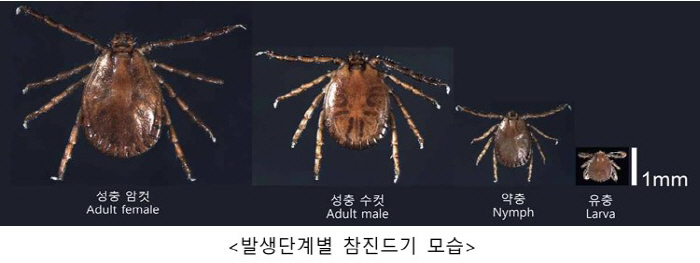Severe febrile thrombocytopenia syndrome-mediated tick warning...No vaccines, no treatments
Apr 14, 2025
|
|
Dermatids have the habit of being parasitic on different hosts and sucking blood in the larval, nymph, and adult stages. From spring (April to May), when the weather gets warmer, nymphs start their activities, and adults spawn in summer (June to July), and in autumn (September to November), the population increases rapidly due to the occurrence of larvae. In Korea, the largest number of small cypress mites inhabit among the SFTS-mediated mites.
SFTS mainly develops symptoms such as high fever and digestive symptoms (nausea, vomiting, diarrhea) within 5 to 14 days of being bitten by a tick carrying SFTS virus from April to November. SFTS has a fatality rate of 18.5%, with 381 deaths out of a total of 2065 patients from 2013 to 2024, when the first case in Korea was reported, but there are no vaccines or treatments yet. Not all tick bites are infected, but it is recommended to follow preventive rules.
According to the results of the National Collection Survey conducted by the Korea Centers for Disease Control and Prevention, ticks carrying SFTS virus had a minimum positive rate of 0.5%, indicating that some ticks were infected with SFTS virus. The Korea Centers for Disease Control and Prevention conducts monthly monitoring of ticks along with the Korea Institute of Health and Environment and the Climate Change Medium Surveillance Base Center in four environments that are likely to come into contact with people in 23 regions across the country.
Ji Young-mi, head of the Korea Centers for Disease Control and Prevention, said, `It is important to follow the tick prevention rules because outdoor activities in spring can increase the frequency of contact with the ticks.'"If you find a tick attached to your body, you should visit a medical institution for safe removal and treatment because it is difficult to remove the snout directly and there is a risk of secondary infection."," he said.
◇Mite prevention rules
① Do not stay in the grass for a long time, do not enter the grass above the ankle, and do not sit or lie down in the grass for more than 30 minutes
② Wearing long clothes, long-neck socks, gloves, hats, etc. during outdoor activities, and using tick repellent at an appropriate cycle for shoes, socks, pants, etc
③ Make sure to wash and check ticks after outdoor activities, observe ticks while bathing or showering
This article was translated by Naver AI translator.















